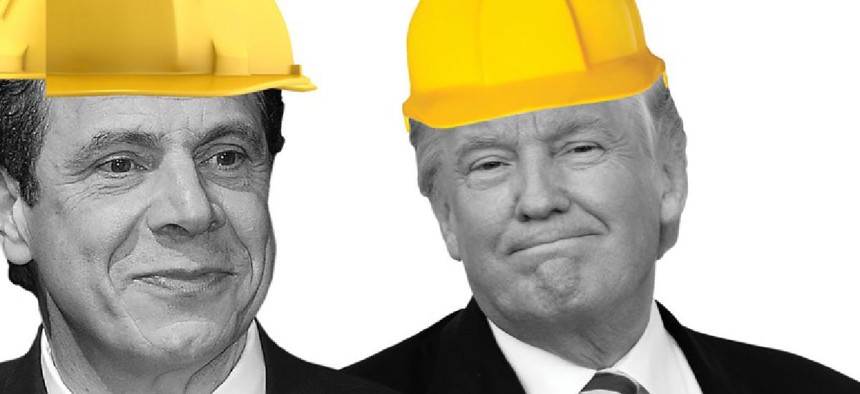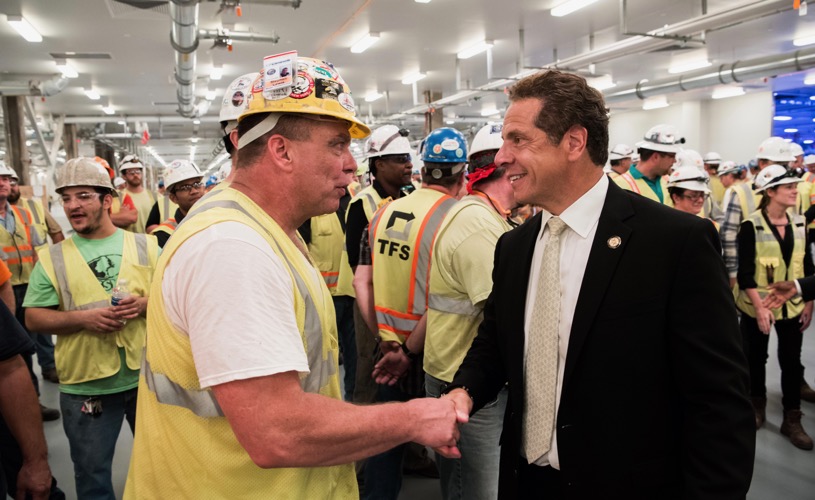Politics
Hard hat hombres: Trump follows Cuomo’s lead with rhetoric around reviving the Rust Belt

.jpg) Kellyanne Conway, the political adviser credited with bringing President-elect Donald Trump’s campaign across the finish line, was in Buffalo this month to deliver a speech at a $5,000-a-plate fundraiser for the transition team.
Kellyanne Conway, the political adviser credited with bringing President-elect Donald Trump’s campaign across the finish line, was in Buffalo this month to deliver a speech at a $5,000-a-plate fundraiser for the transition team.
Inside, on the second floor of the Westin hotel in Delaware North’s brand-new downtown headquarters, guests were greeted with glasses of wine. Outside, a crowd of around 50 protesters rallied against the incoming administration’s controversial positions on the environment, workers’ rights and race relations.
"What you're seeing is, you know, the heartiest people coming out in this cold weather to make this statement, we're rejecting the agenda of corporations and people as profits and children as dollar signs, that we believe in shared prosperity," Louisa Fletcher-Pacheco of the Western New York Working Families Party told Time Warner Cable News.
As Trump moves into the White House this week, the candidate who capitalized on a message of job creation, particularly a pledge to revive manufacturing, will have a lot to prove to voters across the Rust Belt – and not just satisfying well-heeled donors, like those at the Westin.
In Western New York, where Republican politicians were among Trump’s earliest supporters, it begs the question: Will his proposed policies spur employment in upstate New York where he performed extremely well outside of urban areas?
Although Gov. Andrew Cuomo is positioning himself as a liberal foil to Trump, the two men appear to be on the same page when it comes to manufacturing. Both men have emphasized the need to revitalize the struggling sector. Both men have called for tax cuts to spur job creation. And both men have taken credit when companies have created – or saved – manufacturing positions.
Throughout his six years in office, Cuomo has continuously promoted manufacturing hubs, largely based around green technologies, across upstate New York. Through the RiverBend project in Buffalo, the Photonics Institute in Rochester and the Western New York Science Technology Advanced Manufacturing Park outside of Batavia, the governor has been intent on ingratiating himself to upstate residents. Cuomo, perhaps fueled by his loss of Erie County to rival Carl Paladino in 2010, is frequently described by his administration as the most upstate-focused governor in decades.
Standing at the site of the state’s RiverBend factory in August 2015, where the state has spent close to $1 billion building the factory where Tesla will soon begin making solar panels, Cuomo declared victory in turning around the once-bustling manufacturing hub.
“Today, Buffalo has reached a new high,” Cuomo said during the ceremony. “On the gravesite of the old economy, where Republic Steel once stood, now rises a beautiful monument to Buffalo’s future.”
 Cuomo called the near completion of the Solar City Gigafactory at Riverbend a "new high" for Western New York. (Darren McGee - Office of Governor Andrew M. Cuomo)
Cuomo called the near completion of the Solar City Gigafactory at Riverbend a "new high" for Western New York. (Darren McGee - Office of Governor Andrew M. Cuomo)
On the campaign trail, Trump often painted a picture of a revived manufacturing sector in selling his vision of the future to voters.
At an October rally in Ambridge, Pennsylvania, Trump told the crowd he would bring steel manufacturing and mining jobs back to their state.
“Your jobs are coming back to Pennsylvania and they're coming back to this area,” Trump said to the cheering supporters. “That means we're going to take care of steelworkers and we're going to take care of our miners. Believe me, we're going to take care of them.”
What remains to be seen is whether Cuomo and Trump can find common ground on their like-minded goal of returning manufacturing jobs to upstate New York.
Cuomo’s plans may have created jobs – a report from state Comptroller Thomas DiNapoli’s office this summer showed that upstate jobs have increased – though manufacturing actually fell slightly over that time period, with a net total gain of 10,000 positions since the end of the recession. But lucrative incentives and state investment have been necessary to lure companies or convince them to stay.
Trump has taken credit for decisions made by two major manufacturing companies, Carrier and Ford, to reverse course on plans to move some American jobs to Mexico. While details on his plans remain scarce, he has vowed to create a friendlier taxation and regulatory environment at home and increase the tax burden on American companies who want to import their products from countries with cheaper labor costs.
Both companies attributed their moves to public pressure from Trump as well as market forces and other factors.
While Cuomo said shortly after the election that he would be happy to work with Trump on infrastructure projects, which Trump also said would be a priority for him during the campaign, neither the governor’s administration nor the Trump transition team responded to requests for comment on the possibility of working together to create jobs. Some observers have expressed skepticism that the governor and president-elect will be able to come together, at least outwardly, on their common goal of bolstering manufacturing.
During a post-election press conference in December, New York state Republican Chairman Ed Cox and Erie County GOP Chairman Nick Langworthy were loath to offer any praise for Cuomo’s record on manufacturing, even as they agreed with Cuomo that reviving the manufacturing sector is a worthy goal.
Cox, a former SUNY trustee who often pushed for expanded vocational training at the state’s community colleges, characterized job training efforts from both Cuomo and President Barack Obama’s administration as failures. Despite the Cuomo administration promoting job training programs through community colleges linked to anticipated jobs at the RiverBend site and other manufacturing projects, Cox claimed that the Trump administration would make better use of the education system to train people for careers.
“Funds should be going to the community colleges and the community colleges should commit themselves, not just to being junior colleges, but to being comprehensive colleges that do the effective vocational training programs that they are doing now,” Cox said.
But Langworthy said that might not have much of an effect in New York, given its regulatory and tax burdens.
“I don’t care how many programs you put in our colleges. I don’t care how many worker retrainings you do,” Langworthy said. “If it’s not lucrative to build a business here, it’s not going to happen.”
Dick Lipsitz, the president of the Western New York Area Labor Federation, has praised Cuomo’s efforts to create construction jobs and other jobs expected to come from state investment in Buffalo and other upstate communities. Lipsitz said he would also welcome any new jobs that might come from Trump policies, but questioned who would ultimately benefit from the kinds of tax and regulatory changes already outlined by Trump. He added that he doesn’t believe the working class would see any improvement in their quality of life under Trump, even if there are more jobs in manufacturing.
“I think we’re in for the fight of our lives,” Lipsitz said.
The manufacturing sector has gained more than 832,000 jobs nationwide since March 2010, according to the U.S. Bureau of Labor Statistics, but that growth will not be enough to outweigh the damage Trump is likely to do through other policy decisions, he added.
“You start analyzing the issues that really plague working-class people and the trade union movement, there’s not a lot around that you can find that gives you hope that Donald Trump is an alternative that will be positive,” Lipsitz said. “And there’s plenty to worry about that he’ll be a disaster.”

NEXT STORY: Focus on infrastructure, transits inside Cuomo's State of the State proposals